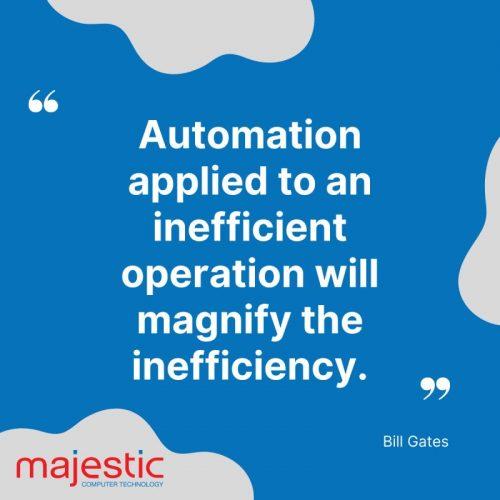How well is your organisation utilising digital technologies as a method of continuous improvement?
An optimised organisation is one where all the pieces of the puzzle fit together. The necessary procedures are in place, supported by the correct tools & equipment. Everyone understands the processes underpinning their roles and the ones adjacent to them. Staff are empowered to make decisions, supported by the framework of optimization that backs their day to day work. Is your organisation as optimised as it could be?
Automation is increasingly being deployed by organisations to help increase their efficiency and effectiveness. However, many businesses look to automation as a solution, when it is in fact, a tool. If an organisation’s processes are inefficient, ineffective, and fail to meet the needs of the business or its clients, then adding automation to them isn’t going to provide the solution it’s looking for. Indeed, automating a process built on inefficiencies often results in a worse outcome, as highlighted in this quote from Bill Gates.
The optimised organisation is characterised by a number of factors:
- Their systems are fit for purpose and work together well.
- Staff understand exactly what they need to do and when
- Staff are well trained in the use of technology
- Handoffs between different departments or different people are well coordinated
- A program of continual improvement ensures that these optimised organisations continue to stay optimised as changes occur.
The optimised organisation has a clear understanding of who they are, where they are, where they are going and how they will get there. They have a well-internalised mission, vision and values. People are empowered, teams are empowered, and individuals are empowered, (within the framework of what the CEO or what the board expects, of course). So what we see in the optimised organisation is that all of the people know exactly what technologies they’re using for what purpose, how they’re going to deliver an outcome and how it will involve others. There is also an incredible amount of transparency between what different people are doing.
Everybody understands where a particular process is up to, who it came from, and who gets it next. There are very few, if any, blockages at all. When there is a workflow that requires multiple people to be involved in it or various approval processes, everybody understands exactly where it’s at. There are systems in place to support a process that gets stuck somewhere. If a particular individual is involved in a process and they’re not doing something when they’re meant to there are systems that will support them with messages, there are systems that will alert other individuals to take care of something so that a timeline doesn’t get missed. All of those things happen automatically.
The optimised organisation takes advantage of technology to really change the way in which they’re delivering processes, the way in which they’re doing things, the very way in which they perform their functions. All of those processes are by default, already dynamic, which means that they can be changed, augmented, modified, or shifted as the need arises. There is a process in place that allows us to improve and continue that cycle of innovation, and that’s how we end up with a really well operating organisation.
In MIT/Deloitte’s 2019 Digital Business Global Executive Survey, only 31% of businesses indicated that they were utilising digital technologies in their processes effectively. And although that percentage is growing year over year, it still represents a large volume of organisations missing out on the benefits that come when its maturity evolves to a high level of well-implemented automation. The way your organisation uses technology can be a key differentiator in your business, increasing your reputation and perceived value in the eyes of your clients.
Forbes’ article ‘How Technology Could Impact the Workplace Over the Next Decade’, attempts to forecast which digital products will be adopted into the workforce and how they will affect the employee experience, including the term ‘hyper-automation’. However, no matter how impressive any technology may seem, it will only ever be an effective strategic choice for an organisation if they first understand how implementing it would fit into, and benefit, the business as a whole.



